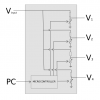Hi all,
Where do I start ?
?
I have attached an image of a electronics module I want to make.
Basically it takes a voltage input and outputs four voltages for which each can be anywhere between 0%(or ground) and 100% of the input voltage.
I want each voltage output to be computer controlled and my very basic understanding is that I can do this with a microcontroller. Again, forgive my limited knowledge, I think I can do this by using a voltage divider on each output and have the microcontroller control a digital potentiometer inside each divider.
I have been thinking along these lines but I have not found a digipot that can work at voltages >15V. My input voltage will be typically 20V DC but may go as high as 200V DC.
Also the outputs will drive static loads (i.e. just electrodes - I am forming an electrostatic field with the four voltages inside a vacuum chamber).
Thanks in advance.
Where do I start
I have attached an image of a electronics module I want to make.
Basically it takes a voltage input and outputs four voltages for which each can be anywhere between 0%(or ground) and 100% of the input voltage.
I want each voltage output to be computer controlled and my very basic understanding is that I can do this with a microcontroller. Again, forgive my limited knowledge, I think I can do this by using a voltage divider on each output and have the microcontroller control a digital potentiometer inside each divider.
I have been thinking along these lines but I have not found a digipot that can work at voltages >15V. My input voltage will be typically 20V DC but may go as high as 200V DC.
Also the outputs will drive static loads (i.e. just electrodes - I am forming an electrostatic field with the four voltages inside a vacuum chamber).
Thanks in advance.

